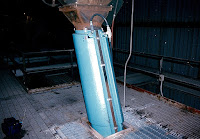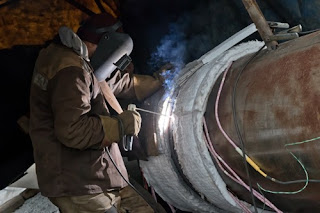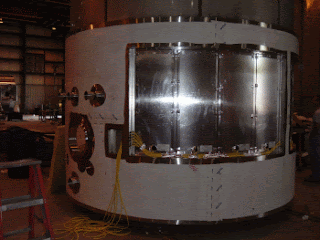For more information call Hotfoil-EHS at 609.588.0900 or visit http://www.hotfoilehs.com.
A blog that provides educational information on electric heating systems used on hoppers, chutes, tanks and vessels; electric heating systems used for pre and post weld heat treating; heat treating power consoles; custom heat treating furnaces; and single & multi-operator welders. For more information, visit HotfoilEHS.com
The Hotfoil-EHS Fusion 45 Induction Heating Console
Induction heating can improve your bottom line by decreasing weld failures, and decreasing setup and tear down times. The technology allows for accurate temp control, without heavy electrical service or complicated controls. The portability and ease of use will allow you to heat more welds faster.
For more information call Hotfoil-EHS at 609.588.0900 or visit http://www.hotfoilehs.com.
For more information call Hotfoil-EHS at 609.588.0900 or visit http://www.hotfoilehs.com.
Induction Heating Provides Welders Uniformity and Shortens Welding Time
Ovens are great for uniformity and control, but require transport and time. They're certainly not convenient.
A great alternative, one that provides excellent uniformity, control, and convenience, is induction heating.
Induction heating is unique because it uses molecular excitation as its source of heat, as opposed to open flames or external electric elements.
Induction heating works very quickly, and since there is no contact with the target piece, there are far less concerns about part contamination. Many industrial processes use induction heating when very high temperatures and uniform control is desired.
Its important to note that the heat is created from inside the object itself, with no open flame or external electric heat source.
Induction heating is used to heat conductive materials. Developed in the early 20th century, it quickly became a popular choice for hardening military equipment parts during wartime. Because of induction heating’s controllability, speed and consistent output, its popularity continued to grow as new manufacturing and production methodologies were developed. Today, induction heating has become a popular technology for the welding industry to provide pre and post-weld stress relief.
Induction heaters provide temperatures and cycle times hard to achieve otherwise. By virtue of their high temperature capabilities, very fast heat up times, precise application of heat, excellent controllability, and ease of setup / breakdown, the use of induction heating has been know to cut 30% to 50% of total weld cycle time in real-life welding applications.
Induction heaters consist of a few primary components: An electromagnet and an electronic oscillator that passes a high-frequency alternating current (AC) through the electromagnet. RF (radio frequency) energy is transferred into the workpiece via electromagnetic waves. These alternating magnetic waves penetrate the object, creating electric eddy currents. These eddy currents (Foucault currents) flow through the target piece and produce heat.
Pre and post-weld heat treating (stress relieving) is a growing market for induction heating systems because it offers significant benefits such as excellent heat placement and distribution, lower cycle times, safety, ease of use, and efficiency.
For more information about induction heaters for pre and post-weld heat treating visit HotfoilEHS at http://www.hotfoilehs.com or call 609.588.0900.
Don't Let Frozen Aggregate Clog Your Process Equipment
 |
| FRP hopper heaters |
 |
| FRP chute heater |
 |
| FRP trough heater |
 |
| FRP trough heater |
Custom Control Panel Fabrication: Start to Finish
Hotfoil-EHS provides custom control panels for a variety of applications. Know for their quality, service, and availability, Hotfoil's experience in designing systems is broad.
Hotfoil-EHS has traditionally focussed on electric heating systems including heating tanks and vessels as well as electric heat tracing, but more recently has developed an expertise in combustion heating system controls. For more information visit http://www.hotfoilehs.com or call 609-588-0900.
Below is a time lapse video of a custom design control panel being fabricated from start to finish.
Hotfoil-EHS has traditionally focussed on electric heating systems including heating tanks and vessels as well as electric heat tracing, but more recently has developed an expertise in combustion heating system controls. For more information visit http://www.hotfoilehs.com or call 609-588-0900.
Below is a time lapse video of a custom design control panel being fabricated from start to finish.
Applying Ceramic Mat Heaters for Pre and Post Weld Heat Treatment
Designed for pre and post weld heat treating, ceramic mat heaters function efficiently for both curved and flat applications. The flexibility of these heaters provides a convenient means to heat treat large metal surfaces in the field.
The application of ceramic mat heaters is straightforward - the heater is placed directly on the part to be welded, insulation is normally laid over the heater, and voltage is applied. A thermocouple is tack-welded near to monitor the part. The part is brought up to temperature and then the welding is done. After the weld, the part is cooled at a controlled rate.
The application of ceramic mat heaters is straightforward - the heater is placed directly on the part to be welded, insulation is normally laid over the heater, and voltage is applied. A thermocouple is tack-welded near to monitor the part. The part is brought up to temperature and then the welding is done. After the weld, the part is cooled at a controlled rate.
 |
| Welding a large pipe with localized heating using ceramic mat heaters. |
 |
| Preparing the pipe for the weld and allowing the heaters to raise the temperature of the pipe. |
 |
| Wrapping ceramic mat heaters around spool piece. |
 |
| Close-up of ceramic mat heaters around spool piece. |
Ceramic Pad/Mat Heaters: The Tried and True Way to Heat Treat
 |
| Ceramic mat heater: Proven performance over time. |
Ceramic pad heaters (also known as mat heaters) are constructed of interlocking sintered alumina ceramic beads (usually pink or white in color) which insulate an 80/20 Nickel/Chrome multi-strand wire (the resistance element).
Ceramic pad heaters are designed for most pre-heat and post-heat treatment requirements on weld joined materials (stress relieving). Available in numerous sizes, shapes, configurations, voltages and wattages, they can be used up to 2150°F in various weld heat treating applications.
 |
| Various shapes and sizes. |
process as well as more efficiently retain the heat for soaking.
For more information on the use and installation of ceramic pad (mat) heaters, visit Hotfoil-EHS at www.hotfoilehs.com or call 609.588.0900.
External Industrial Electric Tank Heating
 |
| Epoxy laminated panel heater installation. |
These electric heating panels use a flat foil resistive element laminated in a multi-layer fiberglass “sandwich” using epoxy resin. Manufactured under tightly controlled heat and pressure to assure bonding and structural integrity, the resulting heater is a water-proof and durable semi-flexible heating panel.
Epoxy laminated panels are used in a variety of applications, from freeze protection to process heating. They are used on either vertical or horizontal metallic or non-metallic tanks with diameters of 48" and above. They are also applied in dry or wet areas, corrosive environments, and carry FM approval for hazardous area use.
No special tools or skills are required, so they are quick and easy to install. Typically the ELPs are installed by banding them to the tank with metal bands or polyester straps, taking just a few minutes. After installation, adhesive aluminum tape should be applied to the edges of the heaters to act as a seal, preventing thermal insulation becoming trapped between the heating panels and the tank.
For more information contact:
HotfoilEHS
2960 East State Street Ext.
Hamilton, NJ 08619
Phone # 609.588.0900
Fax # 609.588.8333
www.hotfoilehs.com
Email: dap@hotfoilehs.com
Subscribe to:
Posts (Atom)

